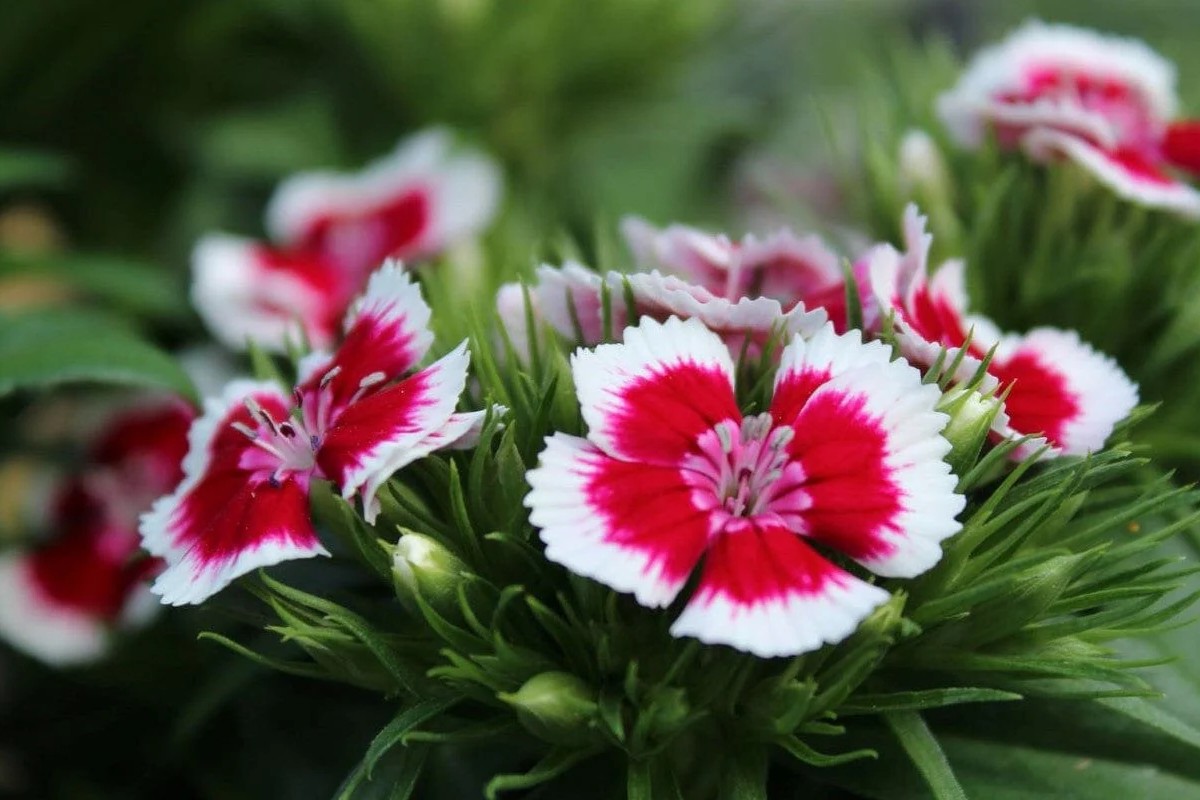
Dianthus, often called "pinks," are charming flowers known for their frilly petals and spicy fragrance. These blooms belong to the Caryophyllaceae family and come in various colors, including pink, red, white, and purple. Did you know that Dianthus flowers have been cultivated for over 2,000 years? They were favorites in ancient Greek and Roman gardens. Their name, derived from Greek, means "divine flower." Dianthus species are not just pretty faces; they also attract pollinators like bees and butterflies, making them excellent for eco-friendly gardens. Whether you're a seasoned gardener or a newbie, these flowers are easy to grow and maintain. Ready to learn more? Let's dive into 33 fascinating facts about Dianthus!
What is Dianthus?
Dianthus, often known as "pinks" or "carnations," is a genus of flowering plants cherished for their vibrant colors and sweet fragrance. These flowers are popular in gardens and bouquets, adding a touch of elegance and charm. Let's explore some fascinating facts about Dianthus.
-
Diverse Species: There are over 300 species of Dianthus, each with unique characteristics and beauty.
-
Ancient History: Dianthus flowers have been cultivated for over 2,000 years, dating back to ancient Greece and Rome.
-
Name Origin: The name "Dianthus" comes from the Greek words "dios" (divine) and "anthos" (flower), meaning "divine flower."
-
Symbolism: Dianthus flowers symbolize love, fascination, and distinction, making them a popular choice for romantic occasions.
-
Variety of Colors: These flowers come in a wide range of colors, including pink, red, white, and purple.
-
Fragrance: Many Dianthus species have a sweet, clove-like fragrance that attracts pollinators like bees and butterflies.
Growing Dianthus
Growing Dianthus can be a rewarding experience for gardeners. These flowers are relatively easy to care for and can thrive in various conditions.
-
Sunlight: Dianthus plants prefer full sun but can tolerate partial shade.
-
Soil: They thrive in well-drained, slightly alkaline soil.
-
Watering: These plants need moderate watering, allowing the soil to dry out between waterings.
-
Pruning: Regular deadheading (removing spent flowers) encourages continuous blooming.
-
Propagation: Dianthus can be propagated through seeds, cuttings, or division.
-
Pest Resistance: They are relatively resistant to pests and diseases, making them low-maintenance.
Uses of Dianthus
Dianthus flowers are not only beautiful but also versatile. They have various uses in gardens, culinary arts, and traditional medicine.
-
Garden Borders: Dianthus is often used as a border plant in gardens due to its compact growth habit.
-
Cut Flowers: Their long-lasting blooms make them ideal for cut flower arrangements.
-
Edible Flowers: Some species of Dianthus are edible and can be used to garnish salads, desserts, and drinks.
-
Medicinal Uses: In traditional medicine, Dianthus has been used to treat various ailments, including digestive issues and skin conditions.
-
Dye Production: The petals of some Dianthus species can be used to produce natural dyes.
Interesting Facts About Dianthus
Dianthus flowers have some unique and surprising characteristics that make them stand out.
-
Evergreen Foliage: Many Dianthus species have evergreen foliage, providing year-round interest in the garden.
-
Cold Hardy: These plants are cold-hardy and can survive frost and freezing temperatures.
-
Attracts Wildlife: Dianthus flowers attract beneficial insects like bees, butterflies, and even hummingbirds.
-
Compact Growth: Most Dianthus species have a compact growth habit, making them suitable for small gardens and containers.
-
Long Blooming Season: With proper care, Dianthus can bloom from late spring to early fall.
-
Hybrid Varieties: There are many hybrid varieties of Dianthus, bred for specific colors, sizes, and fragrances.
Fun Facts About Dianthus
Let's dive into some fun and quirky facts about Dianthus that you might not know.
-
Carnation Day: January 29th is celebrated as Carnation Day in honor of President William McKinley, who loved these flowers.
-
National Flower: The carnation is the national flower of Spain and Slovenia.
-
Birth Flower: Carnations are the birth flower for January, symbolizing love and admiration.
-
Historical Significance: In ancient Rome, Dianthus flowers were used in ceremonial crowns and garlands.
-
Literary Mention: Dianthus flowers are mentioned in Shakespeare's plays, highlighting their long-standing cultural significance.
-
Scientific Research: Dianthus has been studied for its potential anti-inflammatory and antioxidant properties.
-
Cultural Symbol: In Korea, Dianthus flowers are used in traditional ceremonies and symbolize respect and admiration.
-
Color-Changing Flowers: Some species of Dianthus can change color as they age, adding an extra layer of interest.
-
Drought Tolerant: Once established, Dianthus plants are relatively drought-tolerant, making them suitable for xeriscaping.
-
Pollinator Friendly: By planting Dianthus, you can help support local pollinator populations, contributing to a healthier ecosystem.
Final Thoughts on Dianthus
Dianthus flowers, with their vibrant colors and delightful fragrance, have captured the hearts of gardeners and flower enthusiasts alike. These hardy plants are not just beautiful; they’re also versatile, thriving in various climates and soil types. Whether you’re planting them in your garden or using them in floral arrangements, dianthus adds a touch of elegance and charm.
Their rich history, dating back to ancient Greece, adds a layer of intrigue to their beauty. From their medicinal uses to their symbolic meanings, dianthus flowers are more than just pretty petals. They represent love, passion, and admiration, making them perfect for any occasion.
So next time you see a dianthus, remember the fascinating facts behind this lovely flower. Whether you’re a seasoned gardener or a beginner, adding dianthus to your collection is always a good idea. Happy gardening!
Was this page helpful?
Our commitment to delivering trustworthy and engaging content is at the heart of what we do. Each fact on our site is contributed by real users like you, bringing a wealth of diverse insights and information. To ensure the highest standards of accuracy and reliability, our dedicated editors meticulously review each submission. This process guarantees that the facts we share are not only fascinating but also credible. Trust in our commitment to quality and authenticity as you explore and learn with us.
